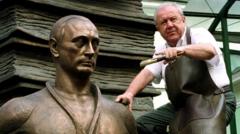Zurab Tsereteli, a celebrated Georgian-Russian artist known for his impressive and often polarizing sculptures, has died at the age of 91. Born in Tbilisi, Tsereteli gained notoriety for his enormous monuments, including a towering 98-meter tribute to Tsar Peter the Great in Moscow, a figure who famously opposed the city he is associated with.
Rising to prominence during the Soviet era, Tsereteli played a pivotal role as the design leader for the 1980 Moscow Olympic Games. His artistic influence extended globally, with significant large-scale works in cities far beyond Russia. His ties with the political elite were well-documented; Tsereteli often cited Russian President Vladimir Putin as a source of inspiration, claiming that his "healthy soul" motivated him to create a bronze study of the leader.
Moscow's mayor, Yuri Luzhkov, was one of Tsereteli's close allies, a partnership that facilitated opportunities that many artists did not have during the Soviet regime, allowing him to connect with art legends like Pablo Picasso in Paris. Following Tsereteli's death, Maria Zakharova, the spokesperson for the Russian Foreign Ministry, hailed him as "an artist of world renown," suggesting that his works would remain a part of collective memory.
His creations have prompted mixed reactions over the years; many Muscovites expressed disdain for the Peter the Great monument in a 2010 survey, even as the art community cherished his expansive vision. Tsereteli served as the president of the Russian Academy of Arts and was known for monumental works such as the Chronicle of Georgia in Tbilisi and a significant memorial to the 9/11 tragedy in New Jersey, which was gifted by the Russian government.
Additionally, Tsereteli's artistic repertoire includes Good Defeats Evil, located at the UN Headquarters in New York, symbolizing peace and the historical treaty ending nuclear tension between the US and the former Soviet Union. Controversy occasionally followed Tsereteli; in 2006, his massive bronze statue of Pope John Paul II faced criticism for breaching France's secular regulations.
Among his record-setting creations is the Birth of the New World monument, stretching 110 meters and originally scheduled for various US cities before finding its home in Puerto Rico. Beyond sculpture, Tsereteli passionately painted, particularly floral still life, while also making significant contributions to architecture, notably in restoring Moscow's Cathedral of Christ the Saviour.
His smaller yet impactful works captured key historical figures, including a statue depicting Winston Churchill, Franklin D. Roosevelt, and Joseph Stalin from the iconic Yalta Conference. Tsereteli's artistic journey reflects both his remarkable contributions to the art world and the complexities of his relationships with political power.



















